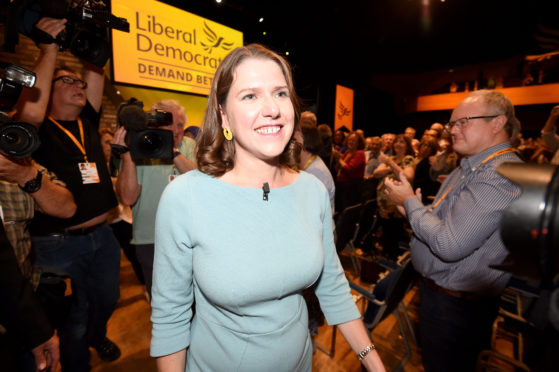
Her big moment should have cast her as a heroic Boadicea-like-figure leading the charge in the March of the Moderates with a clear, coherent and potentially winning message for the Lib Dems on holding another referendum on Brexit.
Instead, Jo Swinson’s first conference speech as her party’s leader has left her portrayed as extreme as Farage and branded a hypocrite.
Having announced that if the Lib Dems won a general election, she’d simply revoke Article 50, cancelling Brexit and riding roughshod over the 17.4 million people who voted for it, Swinson has been so cavalier with democracy, that as a liberal and a democrat, a question mark now hangs over even her party’s name.
And in further polarizing the debate to a choice of extremes – no-deal Brexit or no Brexit at all – she has done nothing to help heal division and bring back some sort of reason to an already bitterly divided nation.
To stoke what Swinson herself has called the “divisive us-against-them rhetoric” is surely not the job of the ‘middle-ground, keen-for-consensus, call-for-compromise, let’s-all-work-together’ Lib Dems, and yet that’s what she’s done.
She may have won the ‘how-to-get-noticed-at-your-first-party-conference-as-leader’ award but also exposed her party to accusations of hypocrisy, reopened the deep wounds created by their time in coalition with the Tories, and sown the seeds of internal divisions that could yet cost her dear.
But for now, there is a smug confidence that has allowed Swinson to suggest, with a straight face, that she could become the next PM and for her party to believe that the momentum is all with them.
The reality is this: Swinson leads a UK party of just 18 MPs and five MSPs. At the 2017 general election, the party won just 7.4 per cent of the vote, trailing massively behind Labour and the Tories, on 40 and 42.4 per cent respectively.
And for all that the party is now nipping at Labour’s heels in opinion polls, when translated into seats, they fall way behind. Labour currently has 247 MPs and the Tories 288.
And while the Lib Dems are avowed critics of the current, first-past-the-post electoral system, they will happily use it now to beat Leavers over the head and overturn the EU referendum result, even if they won an election by a tiny percentage of the vote.
Up until recently, the Lib Dems were the UK’s most obvious pro-Remain party. They wanted a second referendum, campaigned for a People’s Vote, decried parties like the SNP for not getting on board as quickly as them.
Swinson herself was at the fore of bringing the parties together to explore a third way.
But in one stroke, she has overridden all that consensus and goodwill, and gone for broke with revoke.
No wonder the Green MP, Caroline Lucas, says Swinson’s pledge to revoke Article 50 without even having taken it back to the people is arrogant, self-indulgent and cynical.
Swinson has basically said that democracy only counts if it chimes with her world view and to many, that will feel decidedly undemocratic.
Swinson says that asking questions is a key part of being a liberal but she has perhaps also shown to a significant part of the electorate that ignoring the answers is also part of her Liberal DNA.

Enjoy the convenience of having The Sunday Post delivered as a digital ePaper straight to your smartphone, tablet or computer.
Subscribe for only £5.49 a month and enjoy all the benefits of the printed paper as a digital replica.
Subscribe